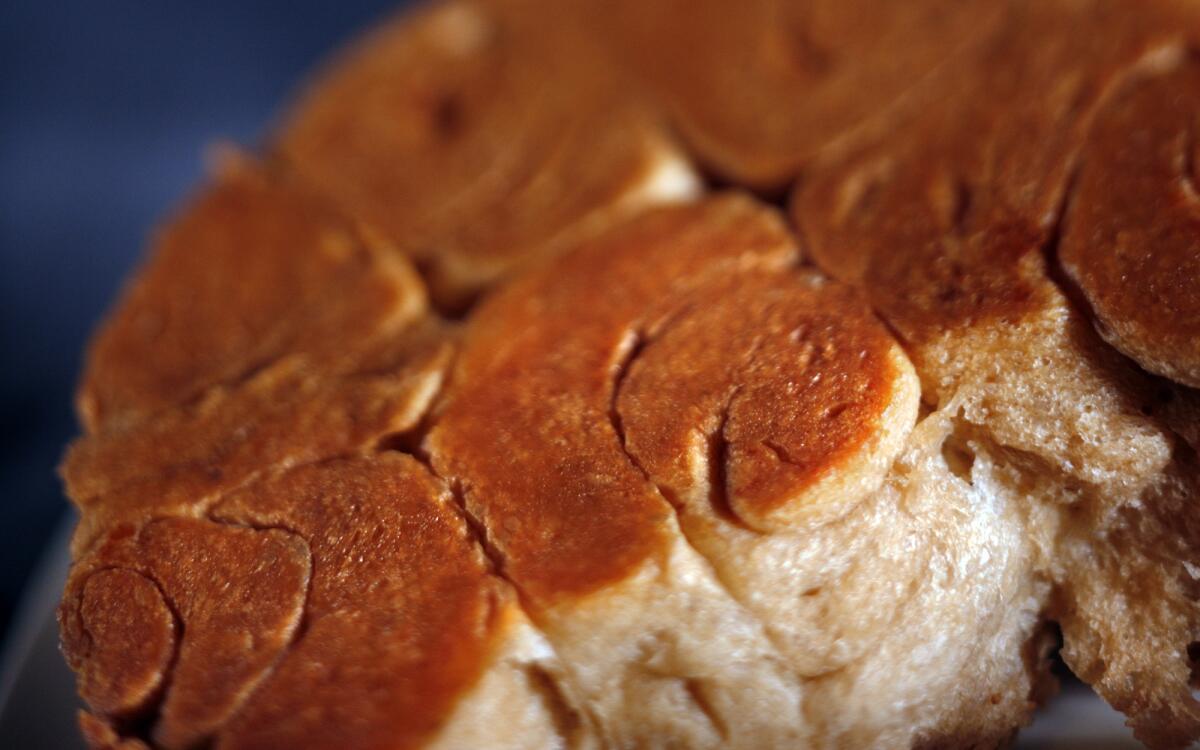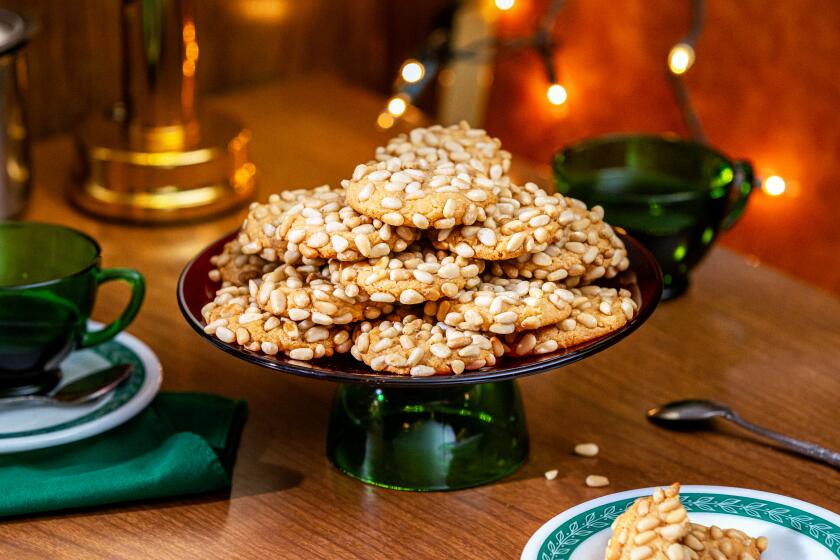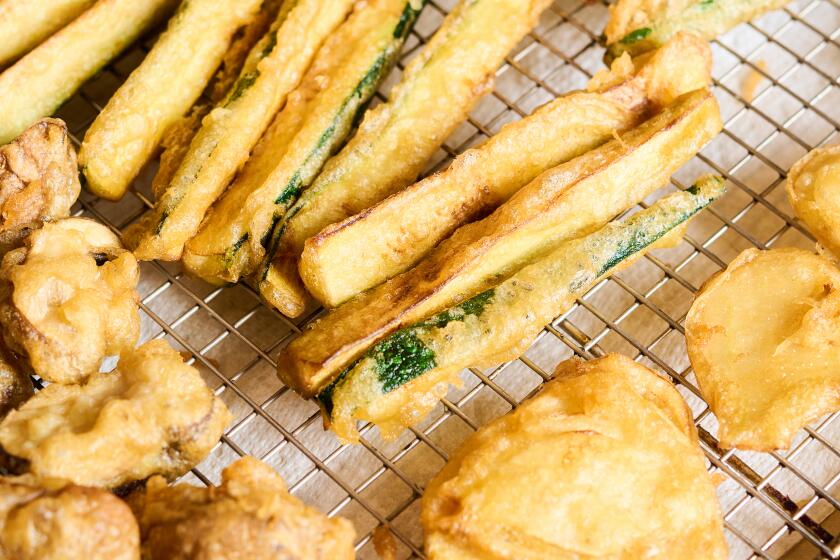Hanukkah kubanah with fig jam (pull-apart Middle Eastern bread)

- Share via
As a child in Hebrew school, I was taught the story of the Hanukkah miracle: When the Jews in the land of Israel defeated the foreigners, the priests seeking to rekindle the temple’s eternal light found enough ritually pure oil for only one day. Miraculously that oil lasted for eight days.
Since then, Jews have been celebrating Hanukkah every year by lighting candles every day for eight days. Children in Israel play with dreidels inscribed with the first Hebrew letters of the phrase “a big miracle happened here”; in Washington, D.C., my birthplace, our dreidels had the first letters of “a big miracle happened there.”
Until I lived in Israel, I associated the holiday with latkes, or potato pancakes. But when I moved there I discovered that for many Israelis, sufganiyot, or jelly doughnuts, are the favorite Hanukkah treat. I also realized that the connection of such foods to Hanukkah is the oil in which they are fried.
What we hadn’t learned in Hebrew school was that the oil of the Hanukkah miracle was olive oil. In ancient Israel, olive oil was used for lighting lamps, for religious rituals and for cooking. Based on archaeological evidence, the land of Israel was an olive oil production center.
Olive oil is rarely used to fry latkes or sufganiyot, specialties that came to us from Central and Eastern Europe, where olive oil is not part of the culinary culture. Yet it seems natural to use the oil of the miracle in Hanukkah menus, along with other foods from biblical Israel. Wheat and barley were staples, and so were vegetables and a variety of fresh and dried fruits, including pomegranates, raisins and olives, which make a colorful topping for the greens of our Hanukkah salad.
Legumes were important in the daily meals of the people of the Holy Land. To make our holiday appetizer, I mix chickpeas, which are native to the Fertile Crescent, with onions sauteed in olive oil, and use the mixture as a filling for turnovers. Such turnovers and other old-fashioned treats were often fried because people didn’t have ovens at home. These days baked treats are more convenient to prepare, keep better when made in advance and are easier to reheat.
In ancient Israel, bread was the center of the meal. For Hanukkah, I bake a holiday kubanah, a slightly sweet bread based on my Yemenite mother-in-law’s overnight Shabbat bread, which I flavor with a touch of fig jam or preserves. To enrich the bread, I spread pieces of the dough with olive oil and softened butter. I roll each piece in a spiral and, as they slowly bake, the pieces come together as a cake.
Hanukkah has become a holiday for potato lovers, even though this New World tuber is a relative newcomer to the lands of the Bible. As an alternative to the common pancakes, I prepare a potato kugel topped with sour cream and cheese, the quintessential foods of the “land of milk and honey.”
In a small bowl, sprinkle the yeast over the lukewarm water and add 1 teaspoon sugar. Set aside until the yeast is foamy, about 10 minutes.
If the jam has pieces of fruit, remove them and cut them into small pieces, about one-fourth inch, and then return them to the jam.
In a large mixing bowl using a wooden spoon, or in the bowl of a stand mixer using a dough hook, combine the remaining 1 tablespoon plus 2 teaspoons sugar, the jam, the salt, 5 tablespoons oil and hot water. Stir until the sugar is completely dissolved.
Add 1 cup flour and stir until the ingredients are blended. Stir in the yeast mixture. Add the remaining 2 cups flour and mix until a dough is formed. If the dough becomes difficult to stir with a wooden spoon, finish mixing the ingredients with your hand; the dough will be soft and sticky.
Knead the dough on a lightly floured work surface, sprinkling a little flour on the dough and on the work surface as necessary, until the dough is very smooth and hardly sticks to the work surface but is still soft, about 10 minutes.
Place the dough in a large, oiled bowl and turn the dough to coat it on all sides with oil. Cover with plastic wrap or a lightly dampened cloth, and set aside in a warm place until nearly doubled in volume, about 1 hour.
Knead the dough briefly in the bowl for 1 or 2 minutes, then set aside to rise again until nearly double, 45 minutes to an hour. Meanwhile, remove the butter from the refrigerator to soften. Cut each piece (about 1 tablespoon) into 2, one larger (2 teaspoons) than the other (1 teaspoon).
Generously butter a deep 2-quart baking dish. Lightly oil a work surface with olive oil. Lightly knead the dough and put it on the work surface. With a heavy knife, cut the dough into 8 pieces. Put them on an oiled plate and cover them with plastic wrap or a lightly dampened cloth.
Oil a rolling pin lightly with olive oil. Roll out one piece of dough on the oiled work surface to a 7-inch square, roughly one-eighth-inch thick.
Take a larger piece (2 teaspoons) of the softened butter, and smear it over the dough piece. With a pastry brush, dab the dough with olive oil. Roll up the dough as in making a jelly roll or cinnamon rolls, pressing firmly; the dough will be shaped like a rope.
Flatten the rope by tapping it firmly with your knuckles until it measures about 7 by 2 inches. Take one of the smaller pieces (1 teaspoon) of butter and smear it over the dough.
Roll the flattened dough rope up tightly into a spiral. Place it in the baking dish with its spiral side facing up. Continue shaping the remaining pieces of dough, placing them one next to the other in the dish. Put a piece of buttered foil directly on the surface of the dough, folding it over the sides of the baking dish. Cover with a tight lid and set aside while heating the oven.
Heat the oven to 225 degrees. Bake the bread until it is golden brown, about 2 hours and 50 minutes to 3 hours; its internal temperature should be about 200 degrees when done.
Turn the bread over onto a plate or platter. Serve the bread hot or warm.
Get our Cooking newsletter.
Your roundup of inspiring recipes and kitchen tricks.
You may occasionally receive promotional content from the Los Angeles Times.















